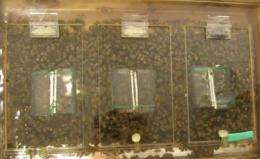Making bees less busy: Social environment changes internal clocks

Honey bees removed from their usual roles in the hive quickly and drastically changed their biological rhythms, according to a study in the Sept. 15 issue of The Journal of Neuroscience. The changes were evident in both the bees' behavior and in their internal clocks. These findings indicate that social environment has a significant effect on the physiology and behavior of animals. In people, disturbances to the biological clock are known to cause problems for shift workers and new parents and for contributing to mood disorders.
Circadian rhythm, the body's "internal clock," regulates daily functions. A few "clock genes" control many actions, including the time of sleeping, eating and drinking, temperature regulation, and hormone fluctuations. However, exactly how that clock is affected by — and affects — social interactions with other animals is unknown.
Senior author Guy Bloch, PhD, and his colleagues from The Hebrew University of Jerusalem, Israel, chose to study bees in part because of their complex social environment. One role in bee society is the "nurse": bees that are busy at all times caring for larvae. This continuous activity is different from other bees and animals, whose levels rise and fall throughout the day.
Bloch and his team thought that changing the nurse bees' social environment might alter their activity levels, so they separated them from their larvae. The researchers found that the bees' cellular rhythms and behavior completely changed, matching a more typical circadian cycle.
"Our findings show that circadian rhythms of honey bees are altered by signals from the brood that are transferred by close or direct contact," Bloch said. "This flexibility in the bees' clock is striking, given that humans and most other animals studied cannot sustain long periods of around-the-clock activity without deterioration in performance and an increase in disease."
The results suggest that the bees' internal clocks were shaped by certain social cues. Jürgen Tautz, PhD, of the Julius-Maximilians Universität Würzburg in Germany, an expert in honey bee biology who was unaffiliated with the study, said it is a wonderful example of the tightly regulated interactions between genes and behavior in a bee colony. "The presence or absence of larvae switched the genes 'on' or 'off,' which guaranteed the adaptive behavior of the bees," Tautz said.
Because bees and mammals' circadian clocks are similarly organized, the question is whether the clocks of other animals also strongly depend on their social environments. The next step is to find just how social exchanges influence gene expressions. Further research into this question may have implications for individuals who suffer from disturbances in their behavioral, sleeping, and waking cycles. Research into how these rhythms may be altered and even stabilized might identify new treatment options.
Provided by Society for Neuroscience
















